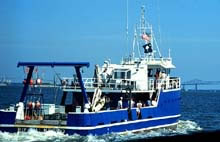 |
 |
 |
|
HOME |
Satellite Tagging of Oceanic Sharks and Billfishes on the Charleston Bump George
Sedberry We propose the following series of hypotheses to be tested in this project: 1. The geological feature of the Charleston Bump is an important habitat for highly migratory and oceanic species of sharks, such as blue shark (Prionace glauca), oceanic whitetip shark (Carcharhinus longimanus), tiger shark (Galeocerdo cuvieri), scalloped hammerhead (Sphyrna lewini) and shortfin mako (Isurus oxyrinchus). These migratory species are resident on the Charleston Bump and use it as a feeding ground. Alternatively, these sharks utilize the Bump as a feeding ground during annual spring migrations. 2, Oceanic sharks concentrate along thermal fronts associated with the Gulf Stream and affected by the Bump, where food is more abundant. Shark Sampling
and Tagging We will tag sharks on the Charleston
Bump using archival satellite
pop-off tags. Priority species
will be those that have commonly occurred in commercial longline catches
and will include the following: There are other sharks
that have been caught off the southeast coast, and which may be encountered. These include: Experimental pelagic longline
sampling will be conducted on the Charleston Bump and areas up- and
downstream from the Bump, including areas where analysis of logbook
data indicate high Tagging will consist of application of satellite pop-off tags. Pop-off tags will be used on sharks because they are not dependent on re-capture of the fish, and can provide essential information on short-term (up to one year) movement of individual fish. These tags will give us information on residence times of sharks tagged in the vicinity of the Charleston Bump, daily vertical movements, and temperature preferences. Sharks and other priority fishes (billfishes, tunas, dolphin) caught on pelagic longlines will be measured, tagged with traditional shoulder tags and released. DNA samples for analysis by the FISHTEC project will be taken from these fishes via biopsy spear. Continuous sea surface temperature, fluorometry and bottom soundings will be taken at the same time that fish sampling is conducted. During all sampling efforts from the R/V Palmetto, we will continuously monitor sea surface temperature and fluorometry. Fluorometer (chlorophyll) measurements will be compared to satellite imagery of sea surface thermal and chlorophyll structure. During deployment of longlines for shark tagging, CTD casts will be made from the surface to 500 m, similar to that conducted during our previous work on the Charleston Bump. Additional bottom mapping, surface temperature and fluorometry measurements, and CTD casts will be performed in areas of discontinuities to resolve thermal fronts and other oceanographic features of particular interest for sampling fishes for tagging. Project Impacts/Results
or Benefits Expected: With additional study of the importance of the Charleston Bump relative to other fish habitats, fishery management plans can be developed that will, it is hoped, provide sustained yields of highly migratory species, sharks and deep reef fishes from the southeast and other regions where these species are fished. Study of movements and recruitment patterns of current or potential fishery species is needed to refine or develop fishery management plans. This is particularly important for species such as sharks, that may have low fishery potential, but which are currently under exploitation. Recent data indicate that many of the highly migratory species such as swordfish and oceanic sharks are severely overfished in the western North Atlantic. Evaluation of the Charleston Bump and its associated oceanographic features in the life history of these species is needed to make wise management decisions. Such decisions might include drastic measures such as seasonal or permanent area closures of the fishery, or designation of a marine reserve. Management decisions regarding
the Charleston Bump should benefit from increased knowledge of the role
of the Charleston Bump in the life history of current and potential
fishery species. The current
management plan for swordfish includes a seasonal closure of the Charleston
Bump region and a permanent closure of the Straits of Florida, another
important swordfishing area and suspected spawning area.
The proposed research will allow government management agencies
to determine if the Charleston Bump is an essential fish habitat that
should be afforded special protection for swordfish, sharks, wreckfish
and other species. |
|
Phone:
843-953-9814 |
George
R. Sedberry Marine Resources Research Institute, SCDNR P.O. Box 12559 217 Ft. Johnson Road Charleston SC 29412 sedberryg@mrd.dnr.state.sc.us |
FAX:
843-953-9820 |

 Tagging
of swordfish with
Tagging
of swordfish with  concentrations
of sharks (See Map).
concentrations
of sharks (See Map).